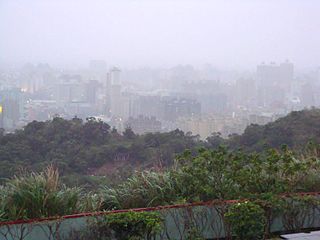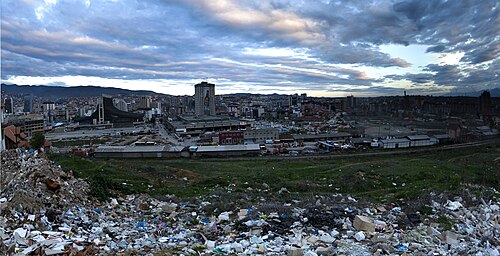
Pollution is the introduction of contaminants into the natural environment that cause adverse change. Pollution can take the form of any substance or energy. Pollutants, the components of pollution, can be either foreign substances/energies or naturally occurring contaminants.

Exhaust gas or flue gas is emitted as a result of the combustion of fuels such as natural gas, gasoline (petrol), diesel fuel, fuel oil, biodiesel blends, or coal. According to the type of engine, it is discharged into the atmosphere through an exhaust pipe, flue gas stack, or propelling nozzle. It often disperses downwind in a pattern called an exhaust plume.

The U.S. National Ambient Air Quality Standards are limits on atmospheric concentration of six pollutants that cause smog, acid rain, and other health hazards. Established by the United States Environmental Protection Agency (EPA) under authority of the Clean Air Act, NAAQS is applied for outdoor air throughout the country.

An air quality index (AQI) is an indicator developed by government agencies to communicate to the public how polluted the air currently is or how polluted it is forecast to become. As air pollution levels rise, so does the AQI, along with the associated public health risk. Children, the elderly and individuals with respiratory or cardiovascular problems are typically the first groups affected by poor air quality. When the AQI is high, governmental bodies generally encourage people to reduce physical activity outdoors, or even avoid going out altogether. When wildfires result in a high AQI, the use of a mask outdoors and an air purifier indoors are also encouraged.

The environment of Belgium is generally affected by the high population density in most of the country. However, due to consistent efforts by the various levels of government in Belgium, the state of the environment in Belgium is gradually improving. These efforts have led to Belgium being ranked as one of the top 10 countries in terms of environmental protection trends. However, water quality still suffers from a relatively low, yet increasing percentage of sewage waste-water treatment, and from historical pollution accumulated in sediments. Air quality is generally good to average, but is affected by emissions from traffic and house heating, and industrial air pollution blowing over from the neighboring heavily industrialized Ruhr-area in Germany. Biodiversity is lower in Flanders than in Wallonia because of population density and fragmentation of habitats, but efforts are being made to boost bio-diversity through connecting fragmented forests and national parks through wildlife crossing "ecoducts" such as in Kikbeek.

The Air Pollution Index is a simple and generalized way to describe the air quality, which is used in Malaysia. It is calculated from several sets of air pollution data and was formerly used in mainland China and Hong Kong. In mainland China the API was replaced by an updated air quality index in early 2012 and on 30 December 2013 Hong Kong moved to a health based index.

Pollution in China is one aspect of the broader topic of environmental issues in China. Various forms of pollution have increased as China has industrialised, which has caused widespread environmental health problems.

Air pollution is the contamination of air due to the presence of substances called pollutants in the atmosphere that are harmful to the health of humans and other living beings, or cause damage to the climate or to materials. It is also the contamination of the indoor or outdoor environment either by chemical, physical, or biological agents that alters the natural features of the atmosphere. There are many different types of air pollutants, such as gases, particulates, and biological molecules. Air pollution can cause diseases, allergies, and even death to humans; it can also cause harm to other living organisms such as animals and crops, and may damage the natural environment or built environment. Air pollution can be caused by both human activities and natural phenomena.

Air Pollution in Mexico City has been of concern to the city's population and health officials for decades. In the 20th century, Mexico City's population rapidly increased as industrialization brought thousands of migrants from all over the world. Such a rapid and unexpected growth led to the UN declaring Mexico City as the most polluted city in the world in 1992. This was partly due to Mexico City's high altitude, which causes its oxygen levels to be 25% lower. Carbon-based fuels also do not combust completely. Other factors include the proliferation of vehicles, rapid industrial growth, and the population boom. The Mexican government has several active plans to reduce emission levels which require citizen participation, vehicular restrictions, increase of green areas, and expanded bicycle accessibility.

Air pollution in India is a serious environmental issue. Of the 30 most polluted cities in the world, 21 were in India in 2019. As per a study based on 2016 data, at least 140 million people in India breathe air that is 10 times or more over the WHO safe limit and 13 of the world's 20 cities with the highest annual levels of air pollution are in India. 51% of the pollution is caused by industrial pollution, 27% by vehicles, 17% by crop burning and 5% by other sources. Air pollution contributes to the premature deaths of 2 million Indians every year. Emissions come from vehicles and industry, whereas in rural areas, much of the pollution stems from biomass burning for cooking and keeping warm. In autumn and spring months, large scale crop residue burning in agriculture fields – a cheaper alternative to mechanical tilling – is a major source of smoke, smog and particulate pollution. India has a low per capita emissions of greenhouse gases but the country as a whole is the third largest greenhouse gas producer after China and the United States. A 2013 study on non-smokers has found that Indians have 30% weaker lung function than Europeans.

The 2013 Eastern China smog was a severe air pollution episode that affected East China, including all or parts of the municipalities of Shanghai and Tianjin, and the provinces of Hebei, Shandong, Jiangsu, Anhui, Henan, and Zhejiang, during December 2013. A lack of cold air flow, combined with slow-moving air masses carrying industrial emissions, collected airborne pollutants to form a thick layer of smog over the region. Levels of PM2.5 particulate matter averaged over 150 micrograms per cubic metre; in some areas, they were 300 to 500 micrograms per cubic metre.

In Turkey, air pollution is the most lethal of the nation's environmental issues, with almost everyone across the country exposed to more than World Health Organization guidelines. Over 30,000 people die each year from air pollution-related illnesses; over 8% of the country's deaths. Air pollution is particularly damaging to children's health. Researchers estimate that reducing air pollution to World Health Organization limits would save seven times the number of lives that were lost in traffic accidents in 2017.

The air quality in Delhi, the capital territory of India, according to a WHO survey of 1,650 world cities, and a survey of 7,000 world cities by the US-based Health Effects Institute in August 2022, is the worst of any major city in the world. It also affects the districts around Delhi. Air pollution in India is estimated to kill about 2 million people every year; it is the fifth largest killer in India. India has the world's highest death rate from chronic respiratory diseases and asthma, according to the WHO. In Delhi, poor quality air irreversibly damages the lungs of 2.2 million or 50 percent of all children.

The World Health Organization guidelines were most recently updated in 2021. The guidelines offer guidance about these air pollutants: particulate matter (PM), ozone (O3), nitrogen dioxide (NO2), sulfur dioxide (SO2) and carbon monoxide (CO). The WHO first released the air quality guidelines in 1987, then updated them in 1997. The reports provide guidelines intending to give guidelines to reduce the health effects of air pollution.

Air pollution in Taiwan is mostly derived from sources of domestic combustion, primarily the burning of fossil fuels. Taiwan's topography has been noted to be a contributing factor to its air pollution problem, leading to poor dispersal and trapping pollutants. Taipei, Taiwan's capital and largest city for example, is surrounded by mountains, and other industrial centers along the northern and western coasts of Taiwan are surrounded by high mountains.
Environmental issues in Toronto encompasses all those concerns and opportunities presented by the environment of Toronto. Many are harmful effects, such as the pollution of air and water, while others are factors influenced by urban infrastructures such as highways and public transportation services. As a result of the city's large population, substantial waste is produced annually.
Environmental issues in North Macedonia include air and water pollution, deforestation, threats to endemic species and climate change. There is substantial degree of pollution in the air, water and land of North Macedonia. According to 2019 estimates, the country is considered to have one of the highest degrees of pollution in Europe.

Air pollution in South Korea is an increasing threat to people and the environment. The air pollution comes from many sources, both domestic and international. Many forms of pollution have increased in South Korea since its rapid industrialization, especially in Seoul and other cities. According to the U.S. National Aeronautics and Space Administration (NASA), Seoul is one of the world's cities with the worst air pollution. From 2009 and 2013, the city's mean PM10 were higher than in many of the largest metropolitan cities in the world such as: Los Angeles, Tokyo, Paris, and London. This has resulted in health and environmental problems. Koreans buy masks and air purifiers to breathe cleaner air, and are working to reduce the country's emissions.
Pollution in Korea has become diversified and serious due to rapid industrialization and urbanization since the 1960s. The causes of environmental pollution, both in South and North Korea, can be found in population growth, urban concentration, and industrial structure, similar to the rest of the world.
Particulate pollution is pollution of an environment that consists of particles suspended in some medium. There are three primary forms: atmospheric particulate matter, marine debris, and space debris. Some particles are released directly from a specific source, while others form in chemical reactions in the atmosphere. Particulate pollution can be derived from either natural sources or anthropogenic processes.



















